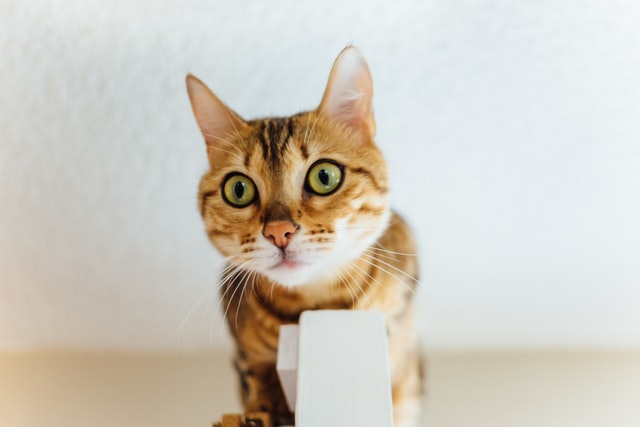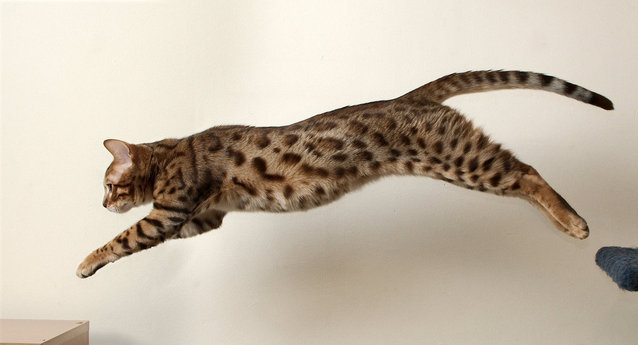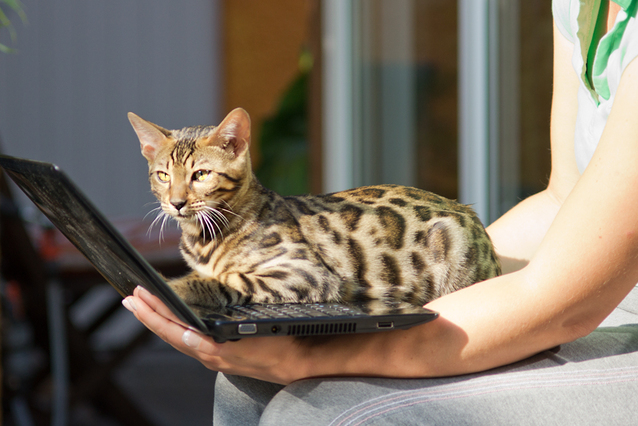A Bengal cat needs a high quality food diet if it’s to live a long, healthy life.
But knowing what constitutes a diet for Bengal cats rich in high quality food isn’t perhaps as straight forward as it seems.
That’s because there is a huge variety of food types available and within these, quality varies.
This guide to Bengal cat food and diet covers all the main categories so like me, you can come away feeling more confident about how best to feed your Bengal.
I’m not an expert- I’m just a Bengal cat owner trying to do the best I can with regards to my cat’s diet.
Some of what you read will be my opinion based on information I found when researching this subject.
What You Will Discover
- What constitutes a good diet for Bengal cats
- The main types of cat food you can buy
- Foods to avoid and what to be wary of when formulating your Bengal’s diet
What Do Bengal Cats Eat?
Put simply, Bengal cats eat meat.
Because like all cats, Bengals are obligate carnivores.
This means they must eat meat to survive as it contains all the essential nutrients to keep them healthy.
But this isn’t as simple as giving your Bengal a chicken breast or any supermarket tin of manufactured cat food.
A good diet for Bengal cats must contain the right mix of:
- Muscle meat
- Organs/Offal
- Bone
Muscle meat in particular is a good source of taurine– just one of the amino acids (the building blocks of protein) cats are unable to synthesise themselves, so must be consumed.
Organs (heart, liver, kidneys) provide essential nutrients and vitamins, with (small amounts of) liver being a good source of Vitamin A for example.
Dietary bone adds much needed calcium.
Now let’s break this down further into specific nutritional requirements…
What Nutrients Must A Bengal Cat Diet Contain?
Put simply, food for Bengal cats must contain the right types and quantities of protein, fat, vitamins, minerals and water.
Protein and Fat
Protein must come from animal sources in order to provide all essential amino acids. It is a cat’s primary energy source.
Fats and fatty acids play a diverse role including providing some of a cat’s energy requirements, transporting fat soluble vitamins and are components of cell structure and function.
The table below gives recommended amounts of dietary protein and fat.

Table taken from here, based on information from Nutrient Requirements of Dogs and Cats (2006)
Please note, amounts required will vary according to the size, age and whether your cat has any illnesses or is pregnant.
Vitamins
Vitamins are organic compounds that support healthy metabolic functions.
They are generally either fat or water soluble.

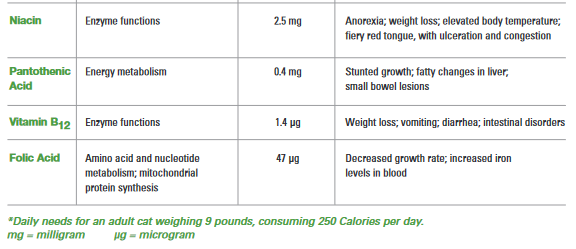
Table taken from here, based on information from Nutrient Requirements of Dogs and Cats (2006)
Deficiencies can lead to health problems, but equally there are those that can be toxic if taken in excess.
Minerals
Minerals are inorganic elements and according to Nutrient Requirements of Dogs and Cats (2006), 12 of which are known to be essential for cats.
This means they are vital for health and must be obtained by Bengal cats from their diet.
Some are only needed in small amounts but they support a wide range of biological functions.
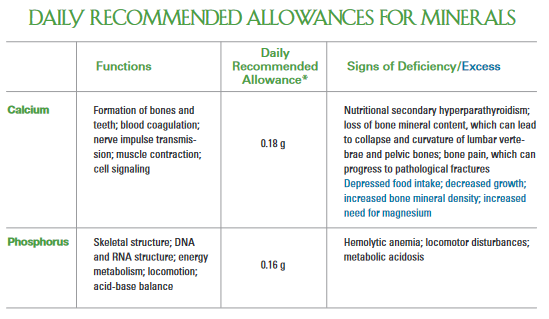
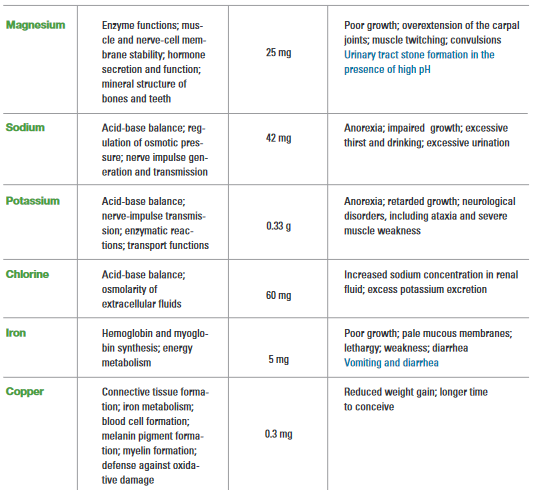

Table taken from here, based on information from Nutrient Requirements of Dogs and Cats (2006)
Calories
Cat energy needs vary according to age, weight, activity levels and whether they are pregnant.
Bengals tend to be more active than cats from other breeds, so their calorie intake may need to be a bit higher.
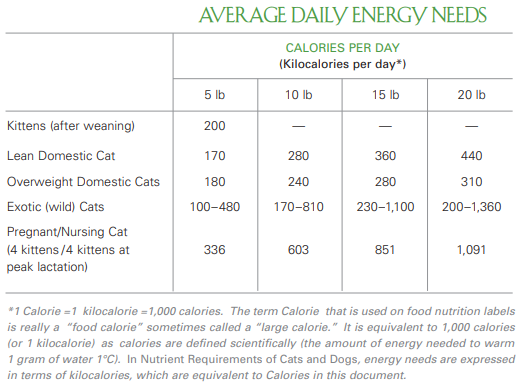
Table taken from here, based on information from Nutrient Requirements of Dogs and Cats (2006)
Shop bought cat food should state how much is needed to provide sufficient calories and maintain a healthy weight.
If you make your own, you will have to work this out.
Now that we know what food a Bengal cat must eat, let’s look what feeding options you as a Bengal owner have…
What To Feed Your Bengal Cat
I’ll be honest, I’ve read a lot on this topic and there seems to be no overall consensus with regards to ‘the best’ food for Bengal cats.
However, there are factors that make sense (to me) with regards to those that are better than others- in terms of nutrition and content.
Of course, owners have to take into account cost, storage and time.
I too am still learning, but here are my findings and you can make a reasoned judgement for yourself.
Raw Food
Small cats in the wild (including the Asian leopard cat from which Bengals owe their ancestry) eat a diet primarily consisting of small mammals, birds, reptiles and insects.
Clearly, a Bengal would not cook its prey once caught but consume it raw.
That includes meat, organs and bones.
Cats are unable to digest starch based foods as effectively as dogs and their diets remain much closer to their wild ancestors.
This is partly due to the fact dogs were domesticated far earlier in human history than cats.
It makes sense to me then, that a diet for Bengal cats resembling what a cat would eat in the wild would be best, although again, this is not scientifically proven to be the case, as discussed here and here.
Your Bengal (although it may try) will not be catching its own food.
Therefore, if you want to feed your Bengal a raw diet, you will have to provide it yourself.
Homemade Raw Food
Raw food can be prepared at home, but there are risks.
Raw Bengal cat food must be complete, balanced and contain all the nutrients essential to survival and good health.
This can be hard to achieve and if done incorrectly can lead to health problems.
A good cat diet should contain roughly 80% muscle meat, 10% organs and 10% bone.
Plus additional supplementation including vitamins and taurine.
This was a such a detailed subject with much to consider, it could be an article on its own, which is why if feeding raw food to your cats is something you are seriously considering I urge you to read the information on Catinfo.org which covers the topic in great detail and from first-hand experience.
You can also find a raw cat food recipe and step-by-step guide put together by the Feline Nutrition Foundation.
However, for balance, this research paper found that many online and book based homemade food recipes were nutritionally inadequate.
Other Factors To Consider Before Feeding A Raw Diet
Aside from ensuring you are feeding a complete raw food diet, the following are also important:
- Type of meat: not only with regards to its source (chicken, turkey, rabbit etc) but also where on the animal it’s from. Muscle meats from thighs are considered preferential to breast for example, owing to higher taurine content.
- Bone content: some meats contain more bone than others, so in order to get the correct amount you may need to add or remove as necessary. Some raw recipes suggest bonemeal which is easier to handle, but that’s not only an extra purchase, your Bengal will also miss out on the nutritional marrow within.
- Equipment: You may well need to acquire equipment ranging from a meat grinder (especially if using whole bones) to suitable and multiple storage containers and even kitchen scales
- Time: removing bones, weighing everything out, grinding, dividing into portions and cleaning takes more time than simply opening a can.
- Storage: to save time, raw food is often made in bulk, but this means having or finding suitable freezer space.
- Cost: buying organic meat is going to be more expensive than non-organic and there’s the repeated cost of supplements plus initial outlay of equipment to take into account.

- Transitioning: your Bengal may be unaccustomed to raw cat food, therefore it could well take time and patience plus some wasted food along the way before your cat adapts (if at all).
- Parasites: raw meat can contain a range of parasites than can be harmful. However, this risk can be reduced significantly buy buying high quality meat aimed at human consumption and by freezing it once prepared.
- Microbial infection: feeding and handling raw meat carries some risk of infection to both cats and humans. This is why the Centre for Disease Control does not recommend feeding your cat a raw diet.
To mitigate the last problem somewhat, some people partially cook meat before feeding it to their Bengal.
Not only does this reduce microbial content, but can make meat more palatable.
However, one must be wary of overcooking meat containing bones as cooked bones become hard and brittle and can cause harm to your cat.
If you like the sound of a raw meat diet for your Bengal cats but aren’t comfortable making one yourself, then you may wish to consider pre-prepared raw food…
Shop Bought Raw Food
You can buy pre-made raw food both online and in some pet stores where it’ll be frozen or dehydrated.
The first thing to ensure it that it’s labelled as a minimum ‘complete’ cat food.
Complete Cat Food: contains sufficient amounts of required nutrients.
Balanced Cat Food: contains all the required nutrients in the correct proportions.
Complimentary Cat Food: may contain some but not all the required nutrients. Should only be fed occasionally alongside a complete diet.
Raw food can be bought in pouches or tubs.
Meat in the latter will need to be divided up into the correct portion size- so a bit of work is needed.
Our Bengal cat was fed (frozen) raw food from tubs (see here), which we continued for a little while, but moved away from owing to cost, storage and minor concerns about bacteria/contamination.
However, it’s something I would consider revisiting, to go alongside what she currently eats.
Dehydrated raw food has a longer shelf life, but you will have to add water to it before feeding it to your cat.
Although clearly more convenient than making your own, commercially available raw food will cost more per portion.
If raw isn’t going to be a viable option for you, then you may well look to cooked canned wet food…
Wet Food
I have in fact written an article exclusively on this subject entitled ‘The Best Wet Food For Bengal Cats.’
I won’t regurgitate the article in its entirety, so if you want more detail, please take a look.
In summary, they are a plethora of options available but plenty to be wary of.
As with commercially bought raw food, the first thing to do is ensure it’s ‘complete’ food.
Ideally, you should aim for a product where calories are provided in the following percentages:
- Over 50% protein (ideally over 70%)
- Between 20-40% fat
- 1-2% carbohydrate maximum
However, in order to establish whether the cat food you’re feeding your Bengal meets these percentages, a calculation is needed.
You should see figures listed somewhere on the box or tin similar to this:
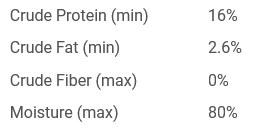
To demonstrate how to calculate what’s known as the ‘crude percentage on a dry matter basis’ for each, we’ll use protein as an example.
Firstly, subtract the moisture percentage from one hundred:
100-80 = 20
Now divide the percentage stated for protein by this figure, so:
16/20 = 0.8
Finally, multiply by one hundred:
0.8 x 100 = 80
This cat food is 80% protein (minimum) on a dry matter basis.
Using this formula, we can calculate that dry fat content is 13%.
Moisture content should also be high- at around 70%.
Carbohydrate levels should be low in any diet for Bengal cats, as they have much shorter intestines than dogs and are therefore less able to digest plants. Prolonged exposure to a high carbohydrate diet can lead to diabetes.
The below table was based on data found here, and was accurate at the time of writing.
Please note that the figures are based on ‘Typical Nutrient Analysis’ which can only be obtained by contacting manufacturers. This gives a more accurate depiction of content.
You will only see ‘Guaranteed Analysis’ on packaging in store which states minimums and therefore will not be as accurate.
Things to know and be wary of
Bengal cat and pet owners in general are becoming more discerning with regards to the food they feed their animals and are increasingly seeking good quality/healthy food for their pets.
In response, manufacturers are employing similar tactics used when marketing human food in order to get you to purchase their products.
You know the sort of thing- pretty images on packaging, using key words like ‘natural’ or ‘grain-free’ and presenting it in a way that makes it look like gourmet dining.
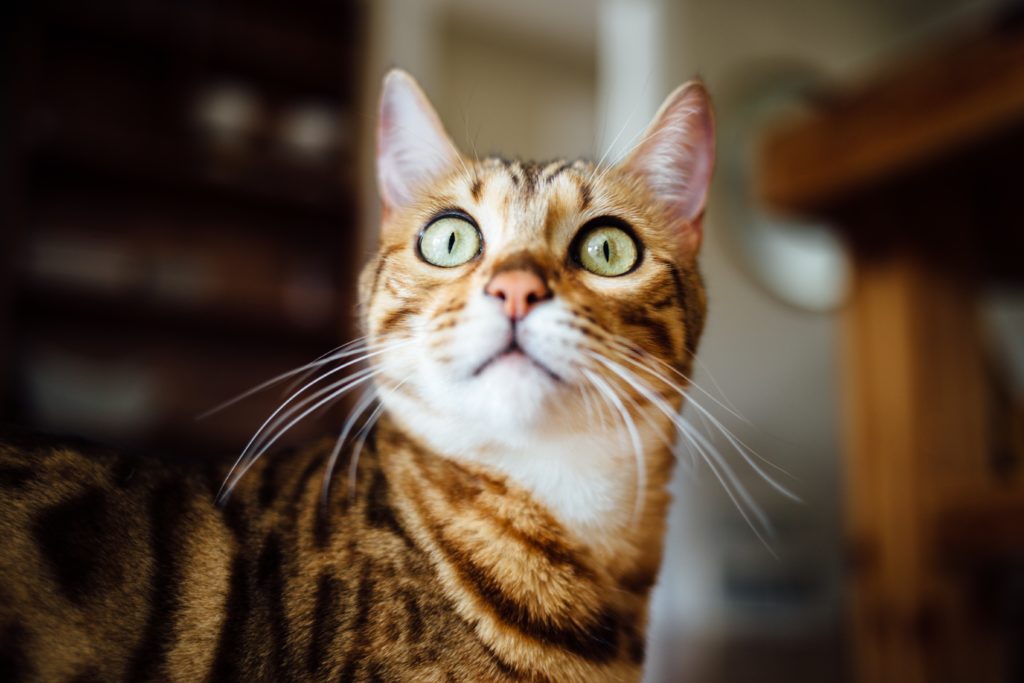
Much of this appeals to humans- a Bengal isn’t going to care whether its food is served under a silver platter or not.
So it is ingredients which should be focussed on, which means understanding some of the terms used and how ingredients are listed…
Order of Ingredients
As with human food products, ingredients are listed in order of highest percentage to lowest.
This means you should be looking for and hopefully find the named meat listed first.
This seems straightforward, but manufacturers employ certain tactics here which muddy the waters.
Ingredient Splitting
Cat food may contain one source ingredient which is split into different ‘daughter’ fractions.
As each fraction is less than the whole, it will appear towards the end of the ingredient list, even though the source ingredient makes up a much larger percentage.
For example, you find corn split into ‘ground corn’, ‘corn meal’ and ‘corn gluten.’
It’s all still corn, but splitting ensures that meat is listed first.
This conveniently brings us onto grains…
Grain-Free
Grains (such as wheat, corn, oats) contain carbohydrates which as we’ve seen, a cat’s diet should contain very little of.
Therefore, by claiming their product is grain-free a company hopes you will think it is a better choice for all cats including Bengals.
However, instead, companies often may replace the term ‘grains’ with ‘cereals’ (something I’ve recently noticed on the food we feed our Bengal) or the actual name of the grain.
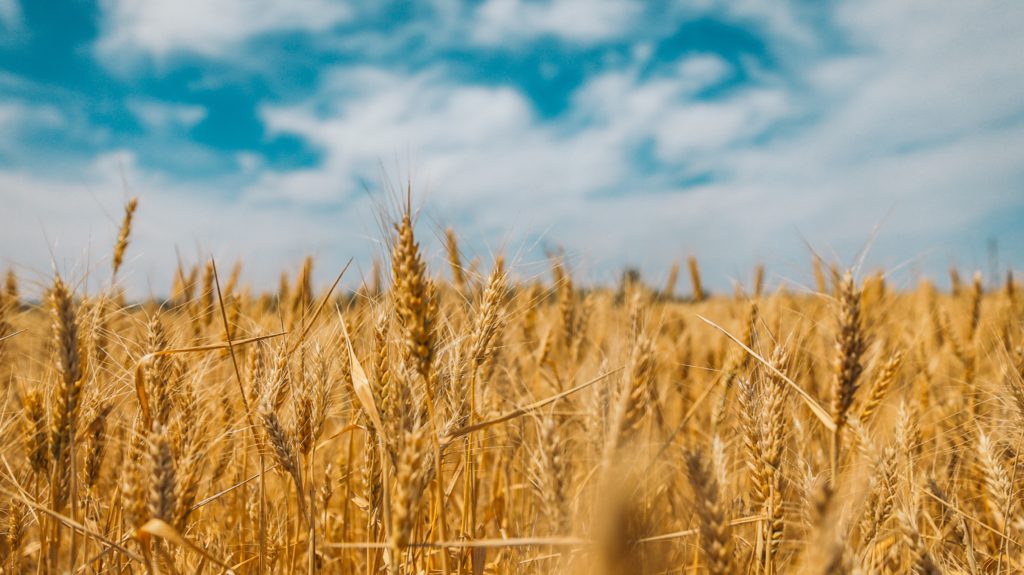
Additionally, you may see vegetables on the packaging as well as the ingredient list.
These too contain carbohydrate which are equally unsuitable in high amounts.
Vegetables and grains are cheaper than meat so help companies increase their profit margins.
Equally, vegetables are good for health- for humans not cats.
But as it’s humans who buy the food, by tapping into ‘vegetables are healthy for humans’ manufacturers hope you will assume they are also beneficial for cats.
And therefore, buy their product.
To avoid problems here, simply look out for wet food with an appropriate carbohydrate content, ignoring any grain-free claims and pictures of carrots on tins.
Meat Derivatives
Another common term you will see listed is meat or animal ‘derivatives.’
This is non-specific for a reason.
Are you more likely to purchase something that states ‘animal derivatives’ or trotters, hooves, ears, feet etc?
Exactly.
These ‘derivatives’ then are likely to be inferior nutritiously.
Colourings, Flavour Enhancers and Preservatives
You will see similar terminology used in human food stuffs.
Again, there are nonspecific for a reason as they add nothing nutritionally to the food.
I suspect it’ll be hard to find wet food without some of these in.
Jelly and Gravy
Many wet foods now either contain jelly or gravy and both aim to make your Bengal cat food more palatable.
Jelly is gelatine made from animal products.
Gravy is the juices from cooked meat thickened up with flour or other non-flour thickeners.
The flour in gravy can add to its carbohydrate.
Which is better? It depends on ingredients used as carbohydrates are to be avoided where possible.
One site suggests gravy made from ‘gums’ like xanthan gum is better for cats, where as another states gravy can add much needed fat.
Personally, I look at overall nutritional content and sometimes feed wet food with gravy; sometimes with jelly.
Of course, your Bengal may make the decision for you.
Fish
We tend to associate cats with a love of eating fish, and in the wild the Asian leopard cat would indeed catch its own.
Fish has typically been considered a healthy choice, but this belief is slowly being eroded.
As our seas become increasingly polluted, heavy metals such as mercury and lead become concentrated in the bodies of higher organisms including fish.
Therefore, anyone or anything that eats fish will too be consuming these potentially health damaging elements.
I avoid Bengal cat food that lists fish and other seafood ‘meat’ as one of its ingredients.
There is an article on the health risks associated with eating fish at nutritionfacts.org. It’s about human consumption but still applies.
Ash
You may have already seen, ‘ash’ listed as a cat food ingredient.
When all the organic matter (that is fat, protein, carbohydrates, water etc.) in food is heated and/or burnt off, the remnant is ash.
This contains important minerals needed to maintain health.
Cans or Sachets?
I have read that pouches generally contain more water than canned food options, which means less calories for your money and therefore a greater volume is needed to keep kitty satiated.
Canned food offers a different problem in that there’s the potential for BPA contamination.
The choice you make here may simply be down to cost or availability.
Wet Food and Teeth
Regular consumption of tinned or pouched wet food according to a number of sources can lead to plaque build-up and other gum/teeth problems.
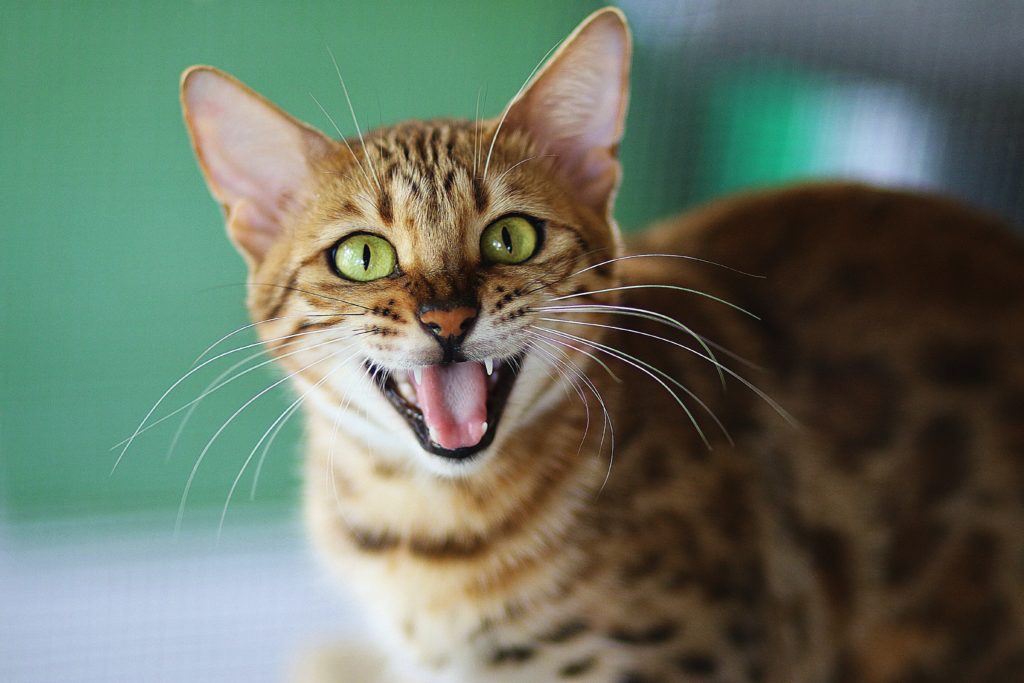
I’ll be honest, I didn’t fancy brushing Hazel’s teeth every day, so I asked a friend with cats what they do with regards to feline dental hygiene.
They use ‘Proden PlaqueOff Powder’ which you just sprinkle onto food once a day. Simple.
I guess time will tell how well it works, but reviews I’ve read are generally very good.
It’s also made from seaweed, which as a carbohydrate, should be avoided in high amounts, but only a small scoop is used per day for cats.
There are claims that dry food is better for a cat’s teeth, but there appears to be no evidence for this.
I have also previously read (although I can’t remember where) that crunching bones from prey or a raw diet helps keep teeth in good condition.
Snacks and Treats
Useful as a reward when it comes to training your Bengal (see ‘How To Train A Bengal Cat To Do Tricks [23 of them]), snacks and treats are abundant in type and flavours.
The most common are probably packets of biscuits and meat sticks.
Personally, I don’t look too much into nutrition with regards to these as our Bengal has them very infrequently and only in small amounts.
I also find rustling a packet is quite useful when wanting to get her attention.
The healthiest snack or treat options seems to be freeze dried meat such as these.
Hazel readily consumes them when given, although the same applies to pretty much all treats.
Occasionally, we would leave out a small portion of dry food for snacking purposes, but for reasons we will delve into next, we have stopped doing so…
What Not To Feed Your Bengal Cat
There are a number of foods that should be avoided either because they’re unhealthy long-term or could cause harm in the short.
The first food type in this section may be surprising to you as it’s dry food…
Dry Food
Dry food, biscuits or kibble is considered by most sources I came across whilst researching this article to be detrimental to a Bengal cat’s health.
It is generally cheaper than wet food and convenient to use- excellent selling points to any would be cat food purchaser.
However, low cost and convenience come at a potential price to your Bengal’s health.
Dry cat foods are highly processed, and processed food lacks nutrients.
Dry food tends to be lower in quality protein content and higher in carbohydrate content- far higher than the acceptable 2-3% level in many cases.
In one particular brand, I have seen cereals listed as the first ingredient.
Salt (which may be called as ‘Sodium ‘Something’) content of dry food tends also to be high.
Conversely, moisture content is low.
Too low.
Cats do not tend to drink a great deal as they should get the vast majority of water they need from meat (which is around 60-75% water)
So a high salt, low moisture diet offered by dry food is a recipe for kidney problems later on in life.
I have also read that microbial content of dry foods can be high especially once opened and left unused.
However, some cat owners and websites still ‘stick up’ for dry food and as mentioned, some claim it helps prevent tooth decay.
From everything I’ve read, it makes sense to me that a diet closest to what adult cats would eat in the wild (minus the risk of infection) would be healthiest.
Which means surely highly processed dry foods can’t be the best Bengal cat food.
Common Foods To Avoid
The following list contain human foodstuffs that a Bengal cat should not consume.
It is by no means complete, but does list those which cropped up most often whilst researching for the article ‘9 Reasons Why Your Bengal Cat Has An Upset Stomach’.
They range from those that contain minor irritation right up to those that can be fatal.
- Onions, garlic, chives, leeks and spring onions
- Chocolate
- Foods/Drinks containing caffeine
- Alcohol
- Grapes, raisins and currants
- Dairy products
- Cooked bones
- Raw eggs*
- Nuts
- Spicy condiments
*Some raw Bengal cat food diets include eggs. Any harbouring salmonella bacteria could be harmful to your cat(s) which is why some don’t recommend feeding a homemade raw diet.
So that’s food, but what about drink?
Water
Whichever Bengal cat diet you decide to pursue, your cats should still be given access to fresh drinking water.
This can simply be tap water in a bowl or two in different locations that your Bengal can easily find.
It would make sense for those that live in larger homes or have multiple cats to put out one bowl per cat, although you will determine over time which of those your cat(s) drink from.
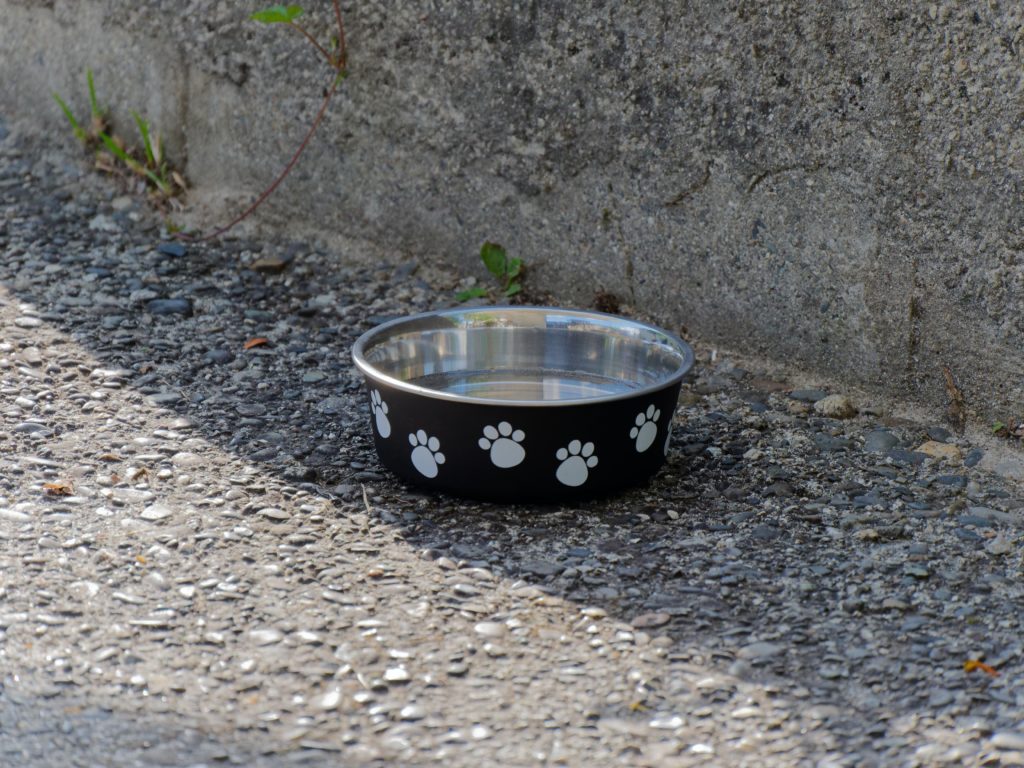
Cats can be picky about what sources they use.
Some prefer to drink from running water such as that from fountains or taps.
Your breeder will advise how your Bengal prefers to receive its water.
Or you can ask.
You may be wondering what we feed our Bengal cat. If so, that’s up next…
What We Feed Our Bengal
*This is now under review once again following further research carried out for this article. I will update accordingly, probably in a new blog post*
We currently feed her pouches of Webbox Naturals– but just the meat selection in gravy.
She’s been contently eating primarily this brand for around a year now and we liked the variety in flavours as well the content.
I also give her a chicken thigh once a week.
I appreciate that although this is raw, it’s not balanced, but it only constitutes a weekly treat.
And she goes crazy for it, growling if I go near her whilst she’s eating.
I don’t know why. I gave it to her- I’m not likely to take it back again.
That’s ‘what’ we feed her, but what about ‘when’ we feed her?
When To Feed Your Bengal Cat
Adult cats in the wild tend to hunt and feed at dusk and dawn.
So that translates as feeding them in the morning and evening.
One site mentioned feeding small amounts multiple times throughout the day, although this may not be possible for many Bengal cats on a raw or wet food diet.
You may want to leave your Bengal something to snack on during the day if you’re not around (we currently don’t do this).
If so, your healthiest bet again would be freeze dried treats.
Let’s now look at how much to feed your pet.
How Much To Feed Your Bengal Cat
If feeding a raw diet then aim to feed your healthy adult cat the amount of food that equates to approximately 3% of its body weight.
If buying, then manufacturers should state how much of their product you should feed your cat.
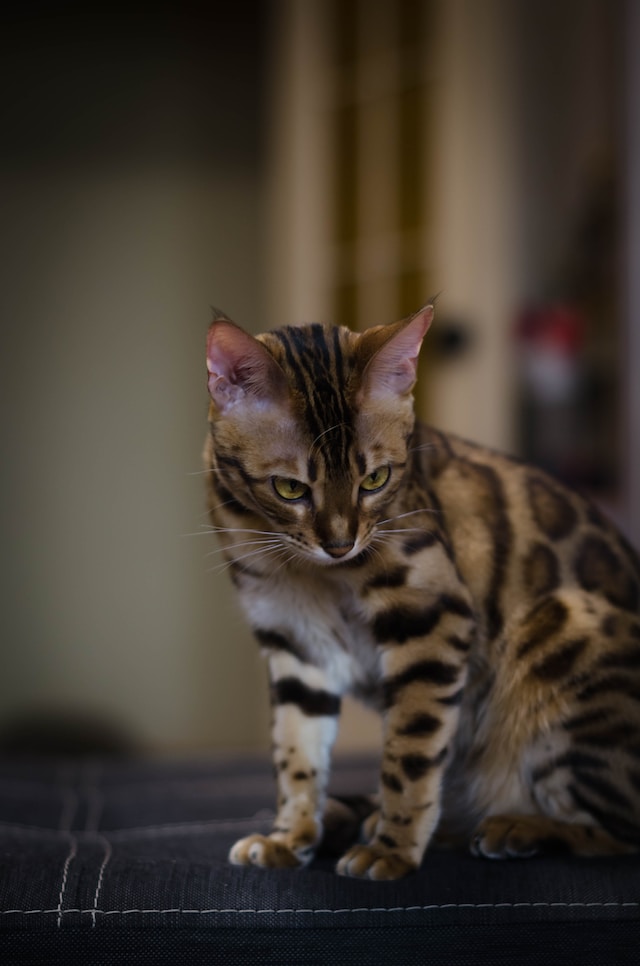
Again, this will be based on weight and assumes your cat has no health problems and is ‘active’.
Sick and pregnant cats may need special diets- something your vet can advise you on.
Also Bengal kittens (up to around 1 year), adult cats (1 year to 10 years) and those classified as seniors (11 years and over) have different nutritional requirements (note that age cut-offs vary according to source).
So you will see food aimed at each of these age groups.
Again, it’s a case of reading labels and dispensing an appropriate amount each day.
Always use treats and extras sparingly as these tend to be less nutritious and if given too readily outside normal feeding times, may contribute to unhealthy weight gain.
Just like humans, cats can have allergies too…
Food Allergies
Bengals can show adverse reactions to particular food stuffs or substances in them.
Problems can arise in Bengal cats if new food in the diet can’t be tolerated or has been introduced too quickly.
And these problems may manifest as health problems such as sickness and diarrhoea.
For more on this and other reasons why your Bengal may have an upset stomach see ‘9 Reasons Why Your Bengal Has An Upset Stomach.’
Next, some questions you may have, although some of these have already been covered…
Can Bengal cats eat dry food?
Yes, Bengal cats can eat dry food.
However, the question should probably be ‘should Bengal cats eat dry food?’
The answer to this seems to be ‘no.’
Can Bengal cats have raw food?
Yes, Bengal cats can have raw food in their diet.
But as already stated this must be complete, balanced and high quality.
Otherwise, a raw food diet can be unhealthy and cause health problems.
Equally, care must be taken with regards to preparation to avoid illness (to humans) from any potentially harmful bacteria.
Do Bengal cats need special food or a special diet?
No, diet requirements for Bengal cats are the same as other domesticated breeds.
Bengals do tend to be more active and energetic, so may therefore have more of an appetite and need a little more to replenish their energy levels and maintain a healthy bodyweight.
What is the best cat food?
There is no definitive best cat food for a Bengal or otherwise.
Complete raw food diets are becoming increasingly popular as they mimic what a cat would consume in the wild.
Wet cat foods (canned food or in pouches) can also provide all a cat needs although some scrutiny of labelling is needed to ensure that what you’re buying is of good quality.
Dry food is best avoided, certainly as the mainstay of a cat’s diet.
Of course, it’s not simply a case of buying or preparing ‘the best.’
There are other factors to take into account when considering a diet for Bengal cats such as convenience, cost and storage.
Is wet cat food better for a cat than dry cat food?
Yes, the consensus on this seems to be that wet cat foods are better than dry cat food.
Wet food is better nutritionally due to higher meat and moisture content and lower carbohydrate content.
At what age can a kitten eat cat food?
According to the book ‘What Cats Want’, weaning- that is, the transition from milk to solid food, can begin once a kitten’s milk teeth start to grow which should be up to 2 months into its life.
This should be specially formulated kitten food and fed in small amounts several times a day.
Bengal Cats Food and Diet Summary
By now, you will have seen that this is by no means a straightforward subject to cover.
In part this is because of much conflicting information as to regards the best Bengal cat food to feed Bengals.
Also, manufacturers are adept at being nonspecific about ingredients and marketing their products as healthy and natural.
Raw meat diets are increasingly popular as they more closely resemble a natural cat diet, but they can be problematic with regards to being balanced and carrying an infection risk, especially if going down the homemade route.
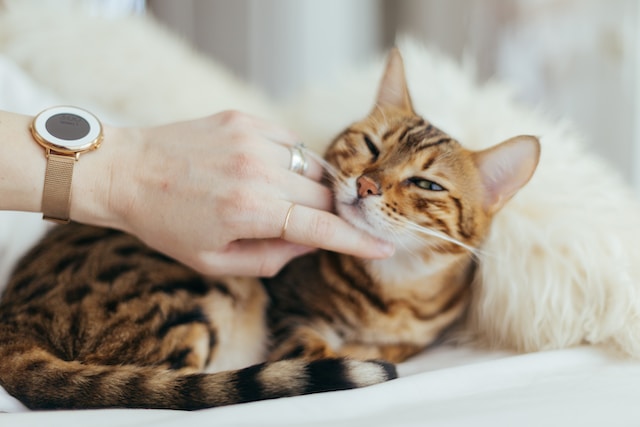
Shop bought raw and cooked wet foods are more convenient but require interrogation of labelling to ensure you’re buying complete, high quality food.
Dry food, although cheap, is best avoided as it is poor nutritionally.
It’s also important to remember that a Bengal kitten will have different nutritional requirements than a senior cat.
Like many, I am always learning and trying to improve how I look after my Bengal so will be reviewing Hazel’s diet to see if I can improve it.
Of course whatever you food decide, your Bengal must agree to eat it…
Further Reading:
Additional Resources:
petmd.com: How Organ Meats Benefit Cats
petmd.com: What Is AAFCO and What Does It Do
petmd.com: Cat Nutrition What Makes Nutritional Cat Food
fda.gov: Complete and Balanced Pet Food
cats.com: The Complete Guide to Feline Nutrition
Please note, Amazon links on this page are affiliate links from which I’ll receive a small percentage if you purchase at no extra cost to you. It all helps. Thanks.
Featured Image by freepic.diller on Freepik

![Bengal Cat Food and Diet: A [Very Good] Guide](https://thatbengalcat.com/wp-content/uploads/2023/06/Bengal-Cat-Food.jpg)



